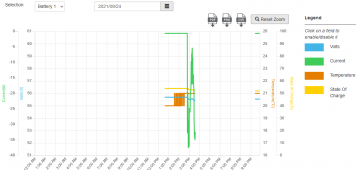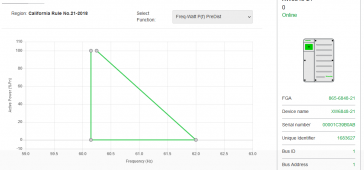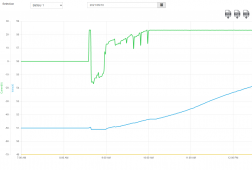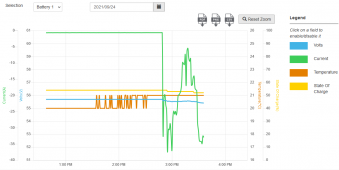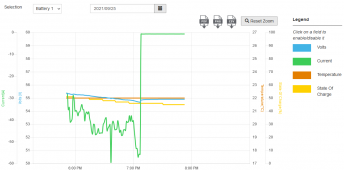That does not make sense.
Battery volts started at about 55.7 volts which is ok, roughly 70% charged, and the current was at zero. Jut before 3 pm the current shoots to -38 amps. That looks like 2,100 watts or so. What was turned on at that point?
Can you do another screen shot, but zoom in the time to cover just 2 pm to 4 pm? You just put your mouse where you want to start on the plot, hold down the mouse button and roll right. When you are where you want the right end, release the mouse button and it should zoom that section to the full plot width.
What were you using to read the frequency? From the InsightLocal web UI, you can just click on Devices and it dhows the power, voltage, and frequency. The sun is down here, so I am running on batteries.
View attachment 66228
My load side is outputting 792 watts at 246.24 volts, and frequency was 59.99, it bounces from that up to 60.01
AC1 input power is zero, but I am actually selling about 1,030 watts back out to my main panel. That is why the battery DC Power is showing -1,737 watts. The numbers move around a bit based on loads. I know it can't be putting out more than it is taking from the batteries, but it is pretty close. It does measure over 95% efficient at this moderate load.
I don't have any solar coming in at this time, so I can't show that, but basically, the AC load side power will go into negative. I will try to kick it off grid again this weekend and see if I can capture what it does. But it certainly is acting different than yours.
The XW Grid Codes section does not effect how it acts while off grid. That is how it responds to grid frequency shift while running on grid so the sell to grid output current meets the local grid code. Looking through my setting, I do not see anything for setting how it handles frequency shift when it is creating the local grid for AC coupling.
Here is a Battery Summary screen grab from my last power failure when the solar was making power.
View attachment 66235
At 8:36 am, I clicked on force charger state (Bulk) to make it start charging before I left for work. I do not have this automated at this time while I am on grid. You can see the battery current jumped right up to 23.4 amps. But that only lasted for 2 minutes as the grid failed at 8:38 am. The battery current drops to -16 amps discharging. The solar was putting out less that 100 watts total, and half of the panels saw the glitch as a bad grid, so, no power from solar yet. Around 8:47 I was up to 11 panels producing power, but the total was still under 150 watts, so not keeping up with my load. The other 5 panels were stuck in a "grid instability" mode, and would not restart. I sent the command to the Enphase Envoy to change the grid code and they all reset and started coming online one by one. As the sun rose, the current went from discharging to charging, exceeding 12 amp of charge by 9 am, while the solar is also supplying all of the power to run my loads in the backup breaker panel. From 9 am to 10 am, the solar keeps ramping up, but at 9:29 9:39 9:49 and finally 9:59 you can see the charge current dip to about 10 amps. I had left the maximum charge rate still set to just 17% as I normally slow charge while on grid, and I forgot to change it as I was running late for work. I think those dips in the current are where the XW saw the current getting close to the charge current limit, so it started shifting the frequency. 5 of my 16 panels saw it as an unstable grid, but they didn't lock out, they reduced power, and then the frequency went back down, so they went back online. 4 times, exactly 10 minutes apart. It is hard to tell, and the log does not have an entry, but it looks like the grid came back on at either 10:03 am, or 10:12 am as those are the two places I see a small inflection in the traces. It reverts to charging from grid right at 23.4 amps again. But since the solar was online, it was actually getting the charging power from the solar, and any additional solar power was selling back out to the AC1 "grid" input of the XW which is in my main panel helping power the loads that are not on the backup panel. With my charge rate set to just 17%, 23.4 amps (over 1,200 watts), I still end up selling back as high as 2,000 watts out to the grid when in full sun. This rate pushes about 9 KWHs into my battery bank before 4 pm. Since I doubled my battery bank, I now push it to 20% charge rate, and push over 10 KWHs.
Mine is still on the older 1.08 firmware, if anything, yours should actually be working better. Something is either wrong in the setup, wiring, or with the device itself.
That does not make sense.
Battery volts started at about 55.7 volts which is ok, roughly 70% charged, and the current was at zero. Jut before 3 pm the current shoots to -38 amps. That looks like 2,100 watts or so. What was turned on at that point?
Can you do another screen shot, but zoom in the time to cover just 2 pm to 4 pm? You just put your mouse where you want to start on the plot, hold down the mouse button and roll right. When you are where you want the right end, release the mouse button and it should zoom that section to the full plot width.
What were you using to read the frequency? From the InsightLocal web UI, you can just click on Devices and it dhows the power, voltage, and frequency. The sun is down here, so I am running on batteries.
View attachment 66228
My load side is outputting 792 watts at 246.24 volts, and frequency was 59.99, it bounces from that up to 60.01
AC1 input power is zero, but I am actually selling about 1,030 watts back out to my main panel. That is why the battery DC Power is showing -1,737 watts. The numbers move around a bit based on loads. I know it can't be putting out more than it is taking from the batteries, but it is pretty close. It does measure over 95% efficient at this moderate load.
I don't have any solar coming in at this time, so I can't show that, but basically, the AC load side power will go into negative. I will try to kick it off grid again this weekend and see if I can capture what it does. But it certainly is acting different than yours.
The XW Grid Codes section does not effect how it acts while off grid. That is how it responds to grid frequency shift while running on grid so the sell to grid output current meets the local grid code. Looking through my setting, I do not see anything for setting how it handles frequency shift when it is creating the local grid for AC coupling.
Here is a Battery Summary screen grab from my last power failure when the solar was making power.
View attachment 66235
At 8:36 am, I clicked on force charger state (Bulk) to make it start charging before I left for work. I do not have this automated at this time while I am on grid. You can see the battery current jumped right up to 23.4 amps. But that only lasted for 2 minutes as the grid failed at 8:38 am. The battery current drops to -16 amps discharging. The solar was putting out less that 100 watts total, and half of the panels saw the glitch as a bad grid, so, no power from solar yet. Around 8:47 I was up to 11 panels producing power, but the total was still under 150 watts, so not keeping up with my load. The other 5 panels were stuck in a "grid instability" mode, and would not restart. I sent the command to the Enphase Envoy to change the grid code and they all reset and started coming online one by one. As the sun rose, the current went from discharging to charging, exceeding 12 amp of charge by 9 am, while the solar is also supplying all of the power to run my loads in the backup breaker panel. From 9 am to 10 am, the solar keeps ramping up, but at 9:29 9:39 9:49 and finally 9:59 you can see the charge current dip to about 10 amps. I had left the maximum charge rate still set to just 17% as I normally slow charge while on grid, and I forgot to change it as I was running late for work. I think those dips in the current are where the XW saw the current getting close to the charge current limit, so it started shifting the frequency. 5 of my 16 panels saw it as an unstable grid, but they didn't lock out, they reduced power, and then the frequency went back down, so they went back online. 4 times, exactly 10 minutes apart. It is hard to tell, and the log does not have an entry, but it looks like the grid came back on at either 10:03 am, or 10:12 am as those are the two places I see a small inflection in the traces. It reverts to charging from grid right at 23.4 amps again. But since the solar was online, it was actually getting the charging power from the solar, and any additional solar power was selling back out to the AC1 "grid" input of the XW which is in my main panel helping power the loads that are not on the backup panel. With my charge rate set to just 17%, 23.4 amps (over 1,200 watts), I still end up selling back as high as 2,000 watts out to the grid when in full sun. This rate pushes about 9 KWHs into my battery bank before 4 pm. Since I doubled my battery bank, I now push it to 20% charge rate, and push over 10 KWHs.
Mine is still on the older 1.08 firmware, if anything, yours should actually be working better. Something is either wrong in the setup, wiring, or with the device itself.
I use the insight local to see what the voltage and frequency are doing. It sound like you are having the same problem I am having, is that I can only get about half of my inverters to come online. My loads are so high that most of my power is used up and little is left for charging.



